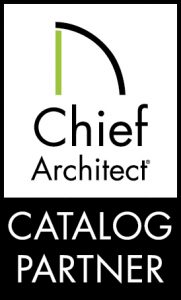Many of you are asking why YesterTec is not manufacturing products right now, when will you be up and running again, and how are you surviving with no output, etc.
Thanks to all of you for your concern! But do understand that I am on the case of finding a suitable company to take YesterTec’s unique products and creative ideas to a whole new level.
Truth is, I, David Beer, YesterTec’s founder, expected to reach high levels of production many years ago. But I chose to sleep at night by hiring subcontractors (instead of building our own factory) to avoid worrying about how to make payroll and/or pay back the loan installments to support all the required capital improvements and overhead. In so doing, I gave up the complete control of all the processes, and thus, we are in this ‘paused’ state today.
But there are several other very successful larger, established companies who do sleep at night because they have infrastructure in place and have talented employees who do their jobs well and allow their products to flourish. I’m hoping to find a company like this, but rather than going into what I’m doing about it, I’m going to tell you the very probable, but for now fictionalized account concerning this larger company’s future, once they’ve acquired YesterTec.
It goes like this:
Turns out an enlightened midsized cabinet manufacturer with national distribution (we’ll call them CM) bought YesterTec, hook, line and sinker. It was easy for them because most of the payment to us is made up from payments over time, collected when they sell products using YesterTec’s designs and technology.
They jumped in because of our U.L. Listed technology (approved in the USA and Canada) that allows the ‘hot’ built-in appliances to be safely concealed behind pocket doors when the appliances are not in use. This technology is the only one of its kind in all the world, and it can be incorporated into as many different applications that can be imagined. CM recognized that the company that controls this technology will have a significant lead over all others in their industry.
CM started small on our advice, making a few models of our extremely popular Armoire style mini-kitchens.
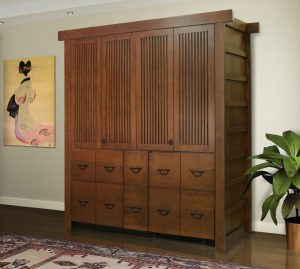
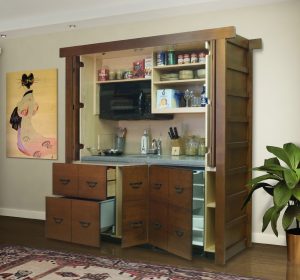
Concealing a complete kitchen inside a beautiful piece of furniture had already been proven to be so appropriate for many residential and commercial uses. Using their in-house marketing strategies including Google Adwords and Social media, they focused on the keywords for these units that were easily recognized and sales took off. Among others, developers in the Tiny home and Accessory dwelling unit (ADU) markets came calling. And why not? Where else can they conceal an entire kitchen, complete with laundry facilities in seven lineal feet of space? And saving space is perhaps the most ‘Green’ strategy of all, think of all the materials and labor saved by building less space!
Concurrently, CM worked our Insert units into their cabinet line.
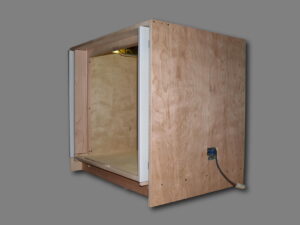
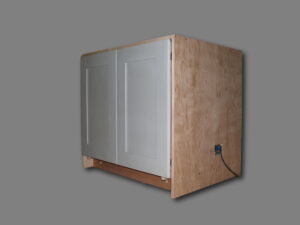
These oven hiding units are the bare bones version of the oven hiding units that are incorporated into YesterTec’s original Kitchen Workstation Furniture (KWF) line. They are made to integrate perfectly with standard cabinetry, so now CM became the only company in the world that could safely hide the ovens inside standard cabinetry.
(By the way, so many other posts in this blog and on our website’s other pages address the ‘Why Furniture instead of cabinetry’ and the ‘Why hide the hot appliances’ issues, so please feel free to wander through our entire site for illustrations of the YesterTec design concepts.)
The building industry media immediately published articles that brought instant recognition to CM, and with further help from social media, CM decided to make the KWF line available to all of their nationwide dealers. Only a few elected to place three or four pieces in their showrooms, but these ‘furnished’ kitchens generated lots of media attention as well, all while sales multiplied. Soon many of the other dealers opted in. Over the 27 years that YesterTec has been manufacturing and promoting the KWF concept, we found that nothing the media sources offer can take the place of a visit to a kitchen display. Standing among the workstations to see how different they are compared to normal kitchen design is an experience that can’t be replicated online or in print.
Some of the dealers in the urban areas of the country decided to display the Stealth Kitchen Module (SKM) line, which includes Mini-kitchen armoires and Lowboy Console complete kitchens as well.
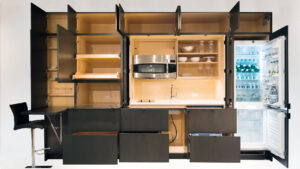
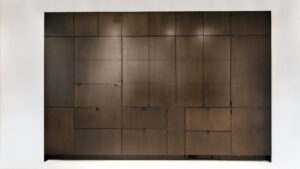
The built-in Stealth line competes with all of the European manufacturers that have been selling minimalist kitchens here for decades. Their designs use large, cumbersome doors that typically stay open all the time. But the SKM line hides everything with more convenient point-of -use panels, making it the leader in the minimalist genre. Alternatively, it is also a most appropriate solution for an uncompromised Period design, because the panels of each module can be styled more traditionally, while hiding all traces of modernity. Just think of a paneled wall inside an 18th C. home. Open the panels and a hidden kitchen emerges!
But then something that we predicted would happen actually happened! A large Furniture Manufacturer (FM) with hundreds of nationwide showrooms decided that they wanted to manufacture workstations and sell a ‘New Room’, the Kitchen.
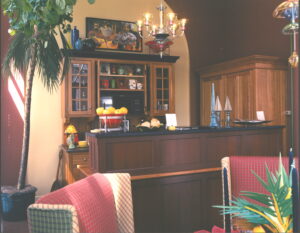
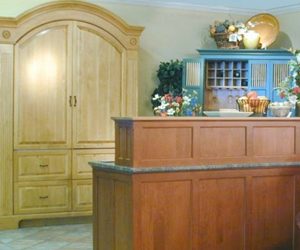
They had always delegated the kitchen to the cabinet manufacturers in the past, but now that a Furniture option existed, they wanted in on it. After all, they were in the business of selling individual pieces of furniture for all the other rooms. Their in-house designers and all other interior designers were trained to created entire rooms with all the trimmings, and now they could do the same for the kitchen, something so appealingly different than designing kitchens with built-in cabinetry.
CM was all in on the idea and licensed the concept to FM while retaining the production of the technology components under their own control. By becoming a licensed manufacturer, the UL (Underwriter Laboratories) inspectors would visit FM’s factory to monitor their adherence to the YesterTec approved standards. FM modestly began placing the mini-kitchens in some of their showrooms, then added more locations as the sales progressed. Soon they added larger kitchen displays of three or more workstations onto the floor of their showrooms and featured even more examples in their online showroom/design centers. A few ‘stock’ models were even available to be purchased online! CM made money selling the electrical components and collecting licencing royalties and all while FM promoted the concepts to larger audiences.Win-win for all!
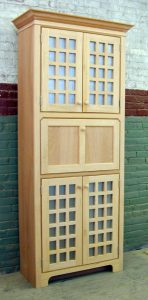
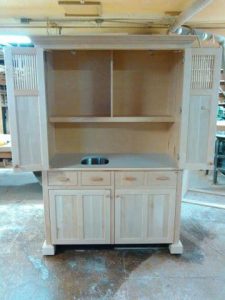
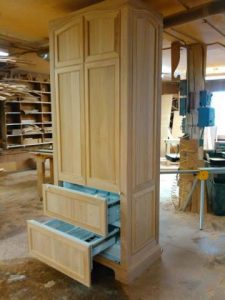
Next, in order to allow any kitchen designer the complete control of the finishing process, CM offered all the products as ‘Gritty Pieces’, a term coined by YesterTec to signify unfinished but sanded pieces, ready for the final finish. Now the market for the workstations that CM manufactured expanded to allow finishing solutions that CM could not meet.
But guess what came next!
CM opened up the Insert line of oven hiding cabinets to ANY and ALL cabinet builders nationwide. By making only the wood parts (they are called enclosures by UL) that are approved by UL and integrating the electrical systems (again approved by UL), any buyer of the units would not need to be a licensed manufacturer. In order to handle the load, CM mass produced these bare bones units that included no doors and trims (the parts that define the finished look of the cabinet) in a dedicated space in their factory. So now any small cabinet builder could have the ability to satisfy their customers’ appliance hiding design ideas that they downloaded from Pinterest!
Hold on, opportunities kept knockin’!
The concept of hiding the ‘hot’ appliances really took off, so much so that it became a staple in the mid to higher end kitchen market. And some of the larger national cabinet companies became manufacturing licensees as well, with CM in total control of each licensing agreement while maintaining complete control of the Electronic division. Some companies only wanted to license certain models, like the unit kitchen manufacturers. Others wanted to build an entire line. And though the licensees are competitors of CM, the styling of all the ‘enclosures’ can be so different, further increasing the popularity of the concepts, which is good for everyone, the producers and above all, the customers.
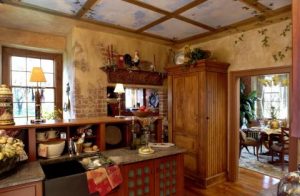
This 14’x14′ farmhouse kitchen fits 4 workstations between 3 doors, 2 windows and a fireplace and includes a breakfast table as well.
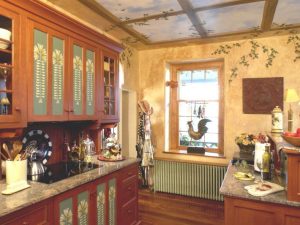
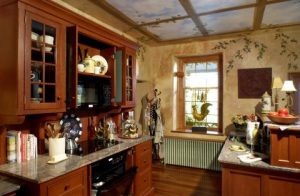
Even a Ready to Assemble (RTA) manufacturer that caters to the Do-it-Yourself market got involved as a licensee by converting specific models to knock-down units using RTA connectors and flat shipping boxes.
Now, CM is adapting the original electrical technology to make the concepts available for other power systems around the world. Though most other countries do not have the stringent requirements that we do in the US, they will value the safety features once they are exposed to them.
CM knew that the most important goal for any business is to provide solutions that can improve their customers lives. By taking control of the designs and technology that YesterTec has created, tested and produced over 27 years, they have become the leader of their field.
I think of this process of change like this: YesterTec wrote the book. CM had the foresight to publish it for the world to use.


